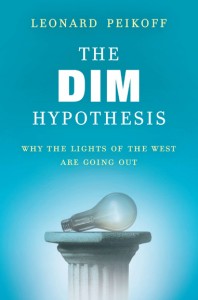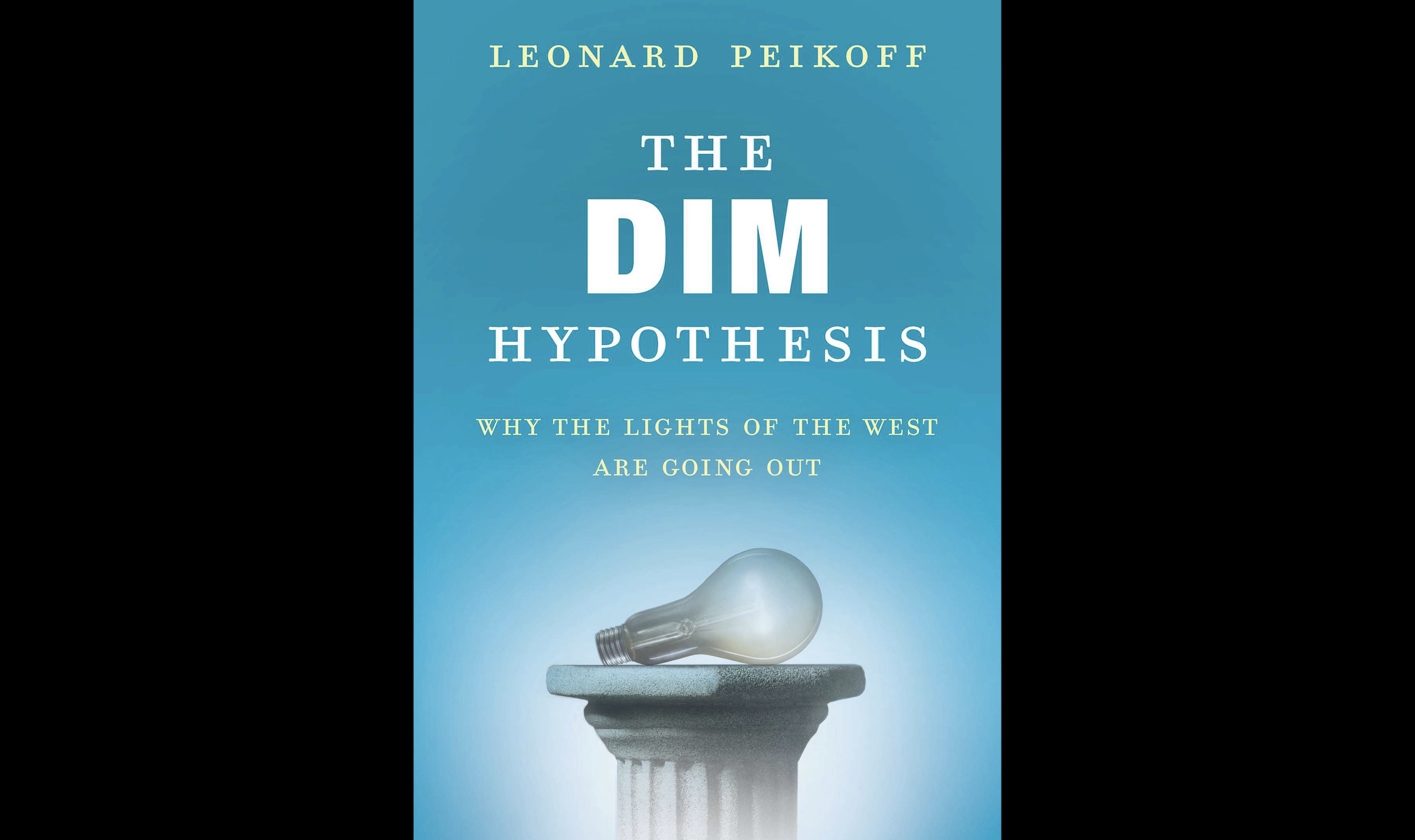The DIM Hypothesis: Why the Lights of the West Are Going Out, by Leonard Peikoff. New York: New American Library, 2012. 400 pp. $27.95 (hardcover).

Is the history of Western Civilization “one great blooming, buzzing confusion,” to adapt the words of William James? Not according to Leonard Peikoff, Ayn Rand’s lifelong student and heir. In his magnum opus, The DIM Hypothesis: Why the Lights of the West Are Going Out, Peikoff persuasively argues that the West’s major historical periods have been driven by, and are defined by, their cultures’ approach to knowledge and the integration thereof.
Do a society’s intellectual leaders preach that all knowledge originates with God or a supernatural dimension, knowable only through faith, mystical intuition, or allegedly “pure” thought detached from the world we see? Or do they recognize the world we perceive as the one true reality, knowable by sensory observation and logical inference therefrom? Or do they hold that there’s no such thing as “reality,” and that “knowledge” refers only to mental constructs of individuals or groups?
The answers to these and related questions, argues Peikoff, are essential to understanding why the West developed as it did—and how it is likely to develop in the future.
Peikoff’s book is extremely abstract, covering the essentials of philosophy and vast expanses of history in a highly condensed presentation. In addition to touching on the highlights of Western philosophy since Thales’s early work in Greece, Peikoff explores major developments in four areas—literature, physics, education, and politics—from Greece to modern times. And he does this in fewer than four hundred pages.
In his preface, Peikoff suggests to readers:
In addition to Objectivism [Ayn Rand’s philosophy], . . . the reader needs to have some knowledge of three epochal philosophers—Plato, Aristotle, and Kant—especially of the distinctive basic principles of each. My summaries in chapter two of the Big Three, as I call them, are the fullest in the book, but they are hardly enough to make the ideas of these thinkers clear to the uninitiated. (p. xiii)
Here I can merely indicate some of the book’s major features to give potential readers the general flavor of its contents and arguments.
What is the “DIM Hypothesis?” “DIM” is an acronym standing for three key concepts explored in the book: disintegration, integration, misintegration. Peikoff offers a preliminary indication of the meaning of these ideas in his first chapter, “Integration.” As it pertains to knowledge, integration means developing one’s knowledge into a logical whole. One who seeks integrated knowledge asks, “for example, [what] is the essence that makes all just acts, despite their many differences, instances of the same concept?” (p. 4). Our ability to integrate knowledge involves our ability to form abstract concepts, Peikoff explains—for example, to observe many particular tables and, from these observations, to form the universal concept of “table” (pp. 6–7). “[T]here are three distinct alternatives in regard to integration: valid integration (e.g., Galileo), invalid integration (Nostradamus), and non-integration (Pollock). This trinity or trichotomy is the base for which DIM . . . is an acronym” (p. 21).
Peikoff formally defines DIM in his fourth chapter, “DIM and the Hypothesis.” By this time, he has explained the three most influential philosophies in Western history, those being Platonism, which holds that we acquire knowledge by contemplating an allegedly higher reality of perfect “forms”; Aristotelianism, which holds that we acquire knowledge by logically integrating our perceptual observations; and Kantianism, which holds that our minds construct what we think of as “reality.” Peikoff explains that M refers to “the Platonic mode ‘misintegration,’” I refers to “the Aristotelian mode” of integration, and D refers to “the Kantian mode ‘disintegration’” (pp. 64–65). (For convenience, I will follow Peikoff in using the letters of the acronym to indicate the modes.)
To grasp Peikoff’s DIM Hypothesis, we must consider the two mixed modes of integration, which Peikoff discusses in his third chapter. It is possible in certain ways to mix either the M mode or the D mode with the I mode of integration. The mixture of M and I yields “worldly supernaturalism,” epitomized by Descartes. Although “Descartes holds that God is ultimate reality, the only perfect being, and the source of all things,” he also sees nature “as fully real and its study as essential in man’s quest for knowledge” (p. 45). Thus, Descartes is a major example of someone who blends the M mode with the I. This combination Peikoff designates as M1, as opposed to a purely Platonic M2.
The mixture of D and I yields “knowing skepticism,” epitomized by the “logical positivism” of Auguste Comte. Although Comte agrees with Kant that “knowledge is relative to man’s faculties,” he also holds that man can grasp “facts knowable by sense perception”—albeit concrete facts, not abstract ones (pp. 53–54). This D1 mode of thought rejects broad abstractions, universal scientific laws, and the like, while allowing for narrow scientific inquiries into the natural world. D1 is thus distinct from D2, which rejects even narrow and piecemeal integrations. Peikoff emphasizes that the mixed modes admit many varieties, each of which may “tilt” more toward or away from I.
After presenting the five DIM modes—the three main ones plus the two mixtures—Peikoff presents his hypothesis in two parts:
The cultural thesis asserts that, since the Greeks’ development of philosophy, cultural fields in the West have produced up to five but no more than five essentially different kinds of products, defined by their mode of integration.
. . . The historical thesis asserts that the West’s mode of integration has changed several times across the centuries, and that this has occurred not by chance, but in substantial part because of the logic of modal progression. If we can gain an understanding of this logic, therefore, we will have a basis for a rational prediction about the West’s future. (pp. 71–72)
Peikoff is quick to distinguish his hypothesis from the Hegelian view: “[My] formulation is intended to exclude any deterministic interpretation of history, such as Hegel’s; in my view, modes do not progress in some pre-ordained sequence independent of human choices or worldly events. Non-modal factors are indisputably essential to historical change” (p. 72).
Nor does Peikoff regard his theory as some a priori truth that precedes observation (which would be an M approach). Peikoff does not regard his hypothesis as proved until after he examines the modes at work in the major periods of history in the literature, physics, education, and politics of those periods.
An example will serve to illustrate the nature of his approach and also to tie his highly abstract DIM modes to some particular cases.
Peikoff’s fifth chapter deals with literature from the 17th century through recent history and focuses on the five major schools of this period: classicism, romanticism, naturalism, modernism, and socialist realism. It so happens that each of those schools manifests a different DIM mode. In classicist literature (e.g., Racine, Pope, Milton), the focus is on abstract thought applied through archetypal characters and events. The classicists’ “credo is the elevation of form over matter,” Peikoff explains: the M1 approach (pp. 84–85). In romanticism (e.g., Rostand, Hugo, Rand), the choices of realistically drawn characters drive an integrated plot, bringing to life an abstract theme: the I approach. Naturalism (e.g., Zola, Sinclair Lewis) rejects abstract themes in favor of a journalistic portrait of man as he is in the here and now: the D1 approach. Modernism (e.g., James Joyce) holds that even the journalistic approach of the naturalists is too abstract; modernists seek to break down plot, characterization, even language itself: the D2 approach. “Destruction is the essence of the Modernist creed,” Peikoff writes (p. 100). And socialist realism presents broad socialist ideals in the form of featureless characters: the M2 approach. “Novels and plays with such content do not present the actions of people; they present a ballet of Platonic forms” (p. 104). This brief summary only hints at the nature of Peikoff’s full discussion of these schools of literature, and the example of literature is only one of many areas he covers.
Why is the DIM Hypothesis important? I will focus on four reasons.
First, DIM helps the reader understand in greater depth philosophy in general and Rand’s philosophy in particular. The DIM modes relate to the two fundamental branches of philosophy, Peikoff explains: metaphysics (concerned with the nature of reality) and epistemology (concerned with the nature of human knowledge) (p. 261). Peikoff’s focus on integration casts the basic questions of philosophy in a new light.
Second, DIM explains how ideas influence history. Humans, alone in their capacity to think conceptually about reality and to contemplate the world in terms of broad abstractions, are motivated fundamentally by the ideas they hold. But how do people’s ideas set the course for the development of a culture over time? Peikoff explains that the mode serves as the “intermediary” between the broad abstractions of philosophy and the particular products of a culture—the art, literature, science, education, politics, and so on. The modes, Peikoff writes, “express philosophy in terms of narrower abstractions—narrower, but still broad enough to apply to cultural products in any field or era” (p. 260). We have seen above, for example, an indication of how the modes make sense of and explain the development of schools of literature.
Third, DIM explains how different pieces of history fit together. What ties together the various aspects of classicist literature? What explains “the later Roman teachers’ obsession with detached linguistic technicalities?” (p. 257). What provides the answers to such questions is the mode of integration (in these two cases the M1 mode). Or, what ties together in our era literary naturalism, the mixed economy, the pluralistic educational system, and positivism in science? (p. 258). Again, the answer is a mode of thinking with respect to integration (in this case D1). Or, what is the connection between Aristotle, Newton, and Hugo? A mode is (here, I).
The DIM modes enable us to see the connections between different elements in our own culture, as well as between elements in different cultures in different eras. DIM is a powerful tool for understanding the essence of a given culture and the progression of cultures.
Fourth, DIM makes sense of otherwise-confusing historical episodes. For me, the most impressive example of this is how DIM explains 20th century totalitarianism. I knew that Kant influenced Hegel, who in turn influenced Marx. But what is the nature of the relationship? In terms of the DIM modes, Hegel reacted to the D2 mode implicit in Kant’s philosophy by concocting an M2 “historical dialectic”—in effect, a supernatural force driving history—and that is what inspired Marx. Thus, the politics of the Soviet Union has more in common with the theocratic totalitarianism of the Middle Ages than it does with today’s mixed economy. That, to me, is a profound insight. Or take the example of environmentalism. It is not true, Peikoff points out, that “the greens are Communism reborn, merely a name change for the reds” (p. 181). Rather, the fundamental motivation of the core environmentalist movement is the destruction of industry and human development: It is a D2 movement. Peikoff continues, “The true color of the environmentalist movement is not red or green, but black” (p. 181).
The DIM Hypothesis entails some interesting problems and difficulties. It covers more material and at a more abstract level than do most books on philosophy; thus it demands an unusually high degree of focus and concentration on the part of the reader. This fact severely limits the number of people who will read and understand the book. And, of those who do read it, few are likely to have sufficient expertise to verify many of Peikoff’s historical claims, or sufficient time to investigate them.
Another problem is that Peikoff does not persuasively support his claim that America likely will lapse into “religious-fascist totalitarianism” within the next few decades (pp. 338, 340). Peikoff bases his dire prediction on the rise of D2 in the culture, which, he argues, will lead to an M2 takeover. I do not think Peikoff has sufficiently accounted for the significant M1 and D1 forces at work in our culture. As examples, the influential literature of J. R. R. Tolkien and J. K. Rowling is M1 (with lifelike, value-oriented characters acting in worlds with religious backdrops); and the libertarians, the skeptics, and the New Atheists are D1, in that they eschew broad abstractions in favor of delimited investigations of aspects of the world.
Despite these weaknesses, The DIM Hypothesis demonstrates that the DIM modes are philosophically sound and that they largely explain the broad course of Western history from the Greeks to today. Peikoff’s book is profoundly important, not only for understanding how the philosophical ideas people embrace substantially drive history, but for understanding how we can effectively play a role in changing our own culture for the better.
















